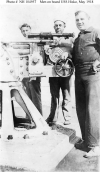Propulsion: Three single ended boilers, one 2,500shp Westinghouse steam turbine with reduction gear, one shaft.
Click on thumbnail
for full size image |
Size |
Image Description |
Source |
 |
67k |
Three Sailors pose with a deck gun, May 1918. A hand-written inscription on the reverse of the original reads: "Creighton & Decker aboard the U.S.S. 'Hisko' enroute from New York to Plymouth Eng. May 3rd to 18th 1918". The original photograph is printed on post card ("AZO") stock
Donation of Dr. Mark Kulikowski, 2007
Naval History and Heritage Command photo NH 104957 |
Robert Hurst |
 |
277k |
Trepassey Bay, Newfoundland, Canada
This picture was most probably taken in May 1919 on occasion of the transatlantic flight of the U.S. Navy Curtiss NC seaplanes. The still camouflaged oiler in the foreground would then be Hisko with the destroyer USS Upshur (DD-144), and another one hidden behind Hisko. Behind the oiler is the minelayer USS Aroostook (CM-3), which operated as a seplane tender for the four NC flying boats. The last ship visible is a destroyer tender
Photo from the George Grantham Bain collection, Library of Congress photo ggbain.28818 |
Commanding Officers
|
| 01 | LCDR Louis E. Congdon, USNRF | 6 December 1917 - 1918 |
| 02 | LCDR John F. Cogan, USNRF | 1918 - 1919 |
Dictionary of American Naval Fighting Ships: Hisko, a tanker (ID 1953), was built by the Chester Ship Building Co., Chester, Pa., and launched 15 October 1917. Acquired by the Navy from the U.S. Shipping Board, she commissioned 6 December 1917 at Philadelphia, Lt. Comdr. Louis E. Congdon in command.After two short runs from New York to Hampton Roads, Hisko sailed for England on 26 January 1918, arriving in Plymouth, through severe winter storms on 12 February. She returned to New York on 8 March. In the following year and a half, the tanker made 11 similar voyages carrying fuel oil to American ships in such scattered points as Devonport, Brest, the Canal Zone, Ponta Delgada, Glasgow, and Newfoundland. Hisko took on oil at New York for most of this period, although she did make three trips to the Gulf of Mexico to load fuel at Port Arthur, Tex., and Baton Rouge, La. Several ships in her convoys, including a French cruiser, were torpedoed by German U-boats, but Hisko escaped unscathed with her valuable cargo.
Hisko returned to New York from her final overseas trip on 28 September 1919. She decommissioned there 1 October 1919 and was returned to the U.S. Shipping Board.
This page created and
maintained by Joseph M. Radigan

|